Please type a search term (at least two characters)
News
EMPIR project successfully validates stack simulators

Working to limit emissions from industrial processes
The project
Hydrogen chloride (HCl) is an acutely toxic industrial pollutant, that readily combines with water vapour to form a component of acid rain and has a greater impact on ecosystems than previously thought. New legislation supporting the EU’s Industrial Emissions Directive, covering waste incineration, iron and steel production, and power generation, establishes more stringent emission limits, yet current test methods aren’t capable of meeting the required levels of accuracy, potentially compromising enforcement of the directive. Input is therefore needed to update best practice guidance, improve test methods and stimulate the development of entirely new test methods.
EMPIR project Determining new uncertainty requirements for increasingly stringent legislative HCl industrial emission limits (18NRM04, Heroes) is working towards providing data, methods, guidelines and recommendations on uncertainty requirements for measuring industrial HCl emissions. Improved quality and certainty regarding emissions data will help national regulators and plant operators achieve full implementation of the directive and supporting legislation realising the reduction in premature deaths the legislation is designed to deliver.
Stack simulators successfully validated
Two stack simulators able to generate homogenous emissions of HCI have had their capability significantly enhanced. The INERIS and NPL stack simulators were successfully validated in accordance with ISO 13528 for the generation of HCl down to 2.5 mg.m-3 and 1 mg.m-3, respectively. This significantly exceeded the project target of <10 mg.m-3 and now provides a capability to generate emissions commensurate with emission limits under Best Available Techniques Conclusions documents, from which national regulators are required to set permit conditions for regulated industrial processes.
This extension of European stack simulator capability represents a significant development and will enable the project to develop two evidence bases. The first to underpin the extension of the current Standard Reference Method (SRM) for measurement at processes regulated via Best Available Techniques Conclusions. The second to underpin a range of portable optical techniques as a possible long-term replacement for the SRM.
Project Coordinator Marc Coleman from NPL said,
‘These enhanced stack simulation facilities will provide the key infrastructure the emissions community needs in the face of increasingly stringent emission limits. They will facilitate the development and testing of measurement methods for standardisation at CEN/ISO, support instrument manufacturers developing next generation techniques, and underpin proficiency testing of ISO/IEC 17025 accredited emission measurement service providers.’
This EMPIR project is co-funded by the European Union's Horizon 2020 research and innovation programme and the EMPIR Participating States.
Want to hear more about EURAMET?
Carbon dioxide, released from man-made activities, is lowering the pH of the Earth’s oceans, and impacting the health of marine organisms worldwide more
Supporting automated and reconfigurable manufacturing systems more
Working with external project Cool White to test and suggest improvements on the locally available white paints more
The project FutureEnergy has provided new calibration services for ultra-high voltages and a good practice guide on Lightning Impulse dividers more
For many of the 5000 photonics companies in Europe a precise knowledge of a material’s optical properties is vital for industrial competitiveness more





